This page and the links below document key developments in the Toyota SUA issue and the search for answers to what appears to be a multifaceted defect.
|
|
Consumer Complaints and Warranty Repairs in NASA-NHTSA’S Toyota Study of Unintended Acceleration [July 21, 2011]
Quality Control Systems Corp. Report
|
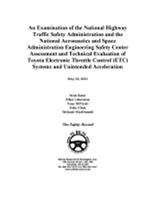 |
An Examination of the National Highway Traffic Safety Administration and the National Aeronautics and Space Administration Engineering Safety Center Assessment and Technical Evaluation of Toyota Electronic Throttle Control (ETC) Systems and Unintended Acceleration [May 23, 2011] |
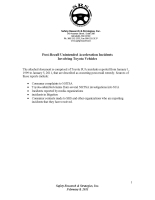 |
Post-Recall Unintended Acceleration Incidents Involving Toyota Vehicles [February 8, 2011] |
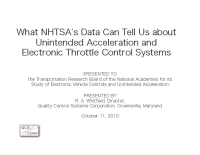 |
What NHTSA’s Data Can Tell Us about Unintended Acceleration and Electronic Throttle Control Systems [October 11, 2010]
PRESENTED TO the Transportation Research Board of the National Academies for its Study of Electronic Vehicle Controls and Unintended Acceleration
Quality Control Systems Corp.
|
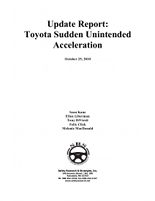 |
Update Report: Toyota Sudden Unintended Acceleration [October 25, 2010] |
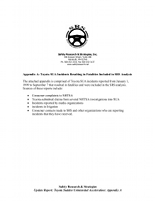 |
Appendices to Update Report: Toyota Sudden Unintended Acceleration [October 25, 2010] |
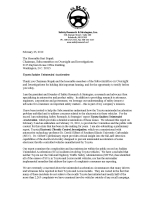 |
Sean Kane’s Statement Before the House Subcommittee on Oversight and Investigations [February 23, 2010] |
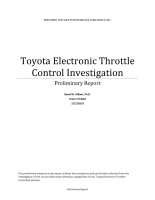 |
Toyota Electronic Throttle Control Investigation: Preliminary Report [February 21, 2010]
Authored by David W. Gilbert, Ph.D. and Omar Trinidad
|
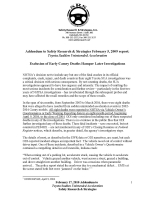 |
Report Addendum: Exclusion of Camry Deaths Hamper Later Investigations [February 17, 2010] |
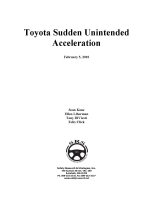 |
Toyota Sudden Unintended Acceleration SRS report covering this continuing safety defect from its roots to the current crisis. [February 5, 2010] |
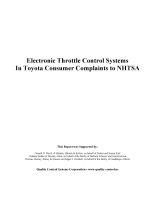 |
Electronic Throttle Control Systems In Toyota Consumer Complaints to NHTSA [February 3, 2010]
Quality Control Systems Corp. Report
|
Toyota Sudden Acceleration Timeline
Toyota Sudden Acceleration Resource Documents
Safety Research & Strategies on Sudden Acceleration
Toyota All-Weather Floor Mat Entrapment
Toyota Sudden Unintended Acceleration: Real Stories
Toyota Replicated Incidents
NHTSA 11/25/09 Press Release
SRS response to 11/25/09 Recall Remedies
Sudden Unintended Acceleration (SUA) is not limited to Toyota and Lexus vehicles, but significant complaint numbers, multiple government investigations, high-profile crashes and recalls to remove floormats has pushed this problem to the top for the number one automaker.
Up until now, Toyota has been successful in blaming all SUA events on wandering all-weather floormats, but the true scope and nature of the problem is likely more complex. Electronics experts say that intermittent and random faults can be the result of radio or electromagnetic interference (EMI), computer algorithms, the integrity of the electrical contacts or semiconductors, or a malfunctioning cruise control system – all of these can result in a runaway vehicle.
In the February 2009 edition of Conformity, a journal devoted to electromagnetic compatibility (EMC) and safety compliance, one British expert says:
“Standards in all industry sectors, including the automotive industry, generally deal with EMI-related safety issues very poorly, if they even cover it at all. The few that attempt to address these issues simply require the application of traditional EMC immunity tests that can never be sufficient for ensuring tolerable safety risks over the entire lifecycle…”
The National Highway Traffic Safety Administration’s apparent stall in moving beyond pedal interference is equally complex. The first issue has been accurate data. In each investigation, the agency has narrowed the scope to the problem as defined by the petitioner, and has ignored other similar incidents. The population of problems has also shrunk due to complaint coding. An SUA event could be listed as an acceleration problem or a braking problem. Further, all SUA fatalities are not being counted by Toyota or NHTSA. The August 29 crash in Santee, California, which killed a California Highway Patrol officer, his wife, daughter and brother-in-law, has undoubtedly raised the profile of SUA. But there have been other fatal SUA crashes involving Toyota vehicles that are not showing up in the government investigations.
The second issue has been the difficulty in reproducing random and intermittent electronic faults in a laboratory setting. NHTSA, with limited time and resources to devote to SUA, has only performed basic tests. Yet, in one instance, the Vehicle Test and Research Center introduced magnetic fields in proximity to the throttle body and accelerator pedal potentiometers of a Lexus ES350, which resulted in an increase in engine revolutions per minute (RPM) of up to approximately 1,000 RPM. Toyota has claimed that it’s impossible for electronics faults to occur without the system taking note, in the form of a stored computer fault code. But the experiences of many drivers belie that claim.
Jeffrey Pepski, of Plymouth, Minn., is the most recent Lexus owner to petition the agency to look at the problem. His SUA event occurred while driving at high speed, in which the vehicle accelerated to 80 mph. Pepski tried pumping and pulling up the accelerator with his foot – to no avail. He slowed the vehicle to about 25 mph, to the smoke and smell of overheated brakes, shifted into neutral, and depressed the start/stop button, but the RPMs began to increase on the tachometer. Pepski shifted back into drive and his Lexus vaulted to 60 mph. Suddenly, the acceleration stopped. He stopped the vehicle, shifted it into park and depressed the start-stop button to turn off the engine. The vehicle shuddered to a halt.
Toyota blamed the incident of a floor mat – despite the fact that Pepski’s vehicle was only outfitted with OE carpet floor mats, not the all-weather mats that are part of the recall.
“I was trapped in a runaway vehicle,” Pepski said. “I was able to push down on the accelerator as well as push up the accelerator with my foot. If the floor mat had been the cause, I would have dislodged it and the acceleration I was experiencing would have gone away and that didn’t happen.”
Regardless of the causes, these incidents of runaway vehicles underscore serious control issues plaguing Toyota’s brake and acceleration systems. In its most recent investigative report NHTSA’s Vehicle Research & Test Center found that drivers would have a difficult time reacting appropriately to an SUA event for three reasons: Many drivers did not know that depressing and holding the ignition button will eventually turn off the engine after three seconds; many complained that the neutral gear position in the gated shift pattern was not immediately obvious; with the throttle plate open, the vacuum power assist of the braking system cannot be replenished and the effectiveness of the brakes is reduced significantly and that brake pedal force in excess of 150 pounds was required to stop the vehicle, compared to 30 pounds required when the vehicle is operating normally.
Adding to the control issues in Toyota and Lexus models is the lack of a brake-to-idle failsafe that many other manufacturers incorporate. This design brings the engine to idle when a conflict is detected between the accelerator and the brake. If both are depressed engine power is cut back to idle, shortening stopping distances greatly.